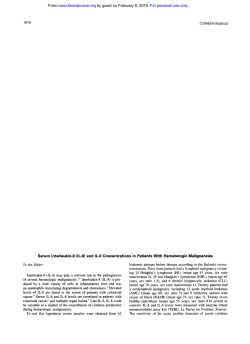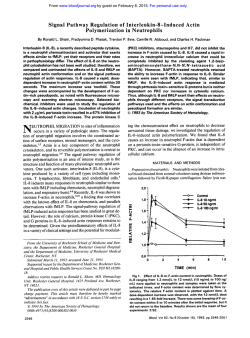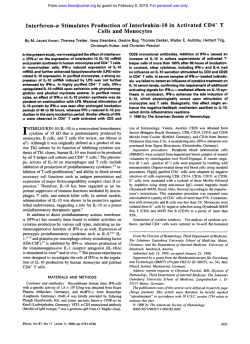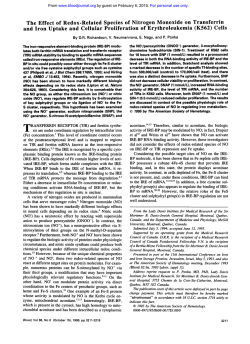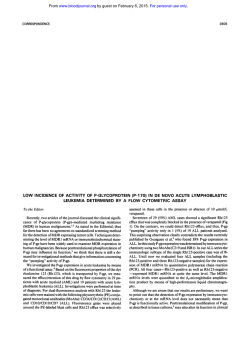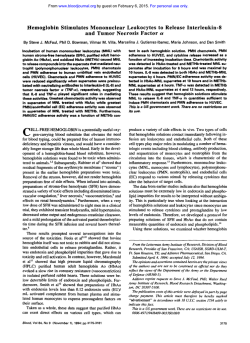
Type-I Interferons Are Potent Inhibitors of Interleukin-8
From www.bloodjournal.org by guest on February 6, 2015. For personal use only. Type-I Interferons Are Potent Inhibitors of Interleukin-8 Production in Hematopoietic and Bone Marrow Stromal Cells By M. Javad Aman, Gregor Rudolf, Jutta Goldschmitt, Walter E. Aulitzky, Charles Lam, Christoph Huber, and Christian Peschel Interleukin-8 (IL-8) is produced by many cell types upon stimulation with bacterial products or inflammation-associated cytokines such as tumor necrosis factor-a and IL-I Interferons (IFNs) represent another group of cytokines that are induced by similar stimuli in inflammatory reactions. We show now that type-I IFNs are potent inhibitors of IL-8 expression in vitro and in vivo. A significant reduction of both secretion of IL-8 protein and accumulation of IL-8 mRNA in vitro was observed in several cell types comprising peripheral blood mononuclear cells (PBMNC) from healthy donors and from patients with chronic myelogenous leukemia (CML), the myelomonocytic cell line THP-1, and bone marrow (BM) stromal cells as a representative model for BM microenvironment. By contrast, in lipopoly- . saccharide-stimulated polymorphonuclear phagocytes IFN failed to suppress IL-8 expression. In untreated patients with CML, a constitutive expression of IL-8 mRNA was detected in freshly isolated PBMNC that was markedly reduced 5 hours after therapeutic application of IFN-a. The mechanism of IL-8 downregulation was studied more in detail in the THP-1 cell line. The experiments showed that de novo protein synthesis was not required for the inhibitory effect. RNA decay analysis and nuclear run-on assays suggest that in THP-1 cell line the inhibitionof IL-8 expression is predominantly regulated at the posttranscriptional level. 0 1993 by The American Society of Hematology. L OCAL ACCUMULATION of neutrophils in inflammareported in fibroblast^.^^ We have studied the role of type-I tory disease states is predominantly regulated by reIFNs on expression of IL-8 in hematopoietic and bone lease of chemotactic substances and a recently recognized marrow (BM) stromal cells in vitro and after in vivo applicagroup of cytokines, the interleukin-8 (IL-B)/monocyte chetion of IFN-a to patients with chronic myelogenous leukemotactic and activating factor (MCAF) family of chemomia (CML). Our results show that IFNs downregulate IL-8 kines.I4 Chemotactic activity induced by IL-8 is associated production in vivo and in vitro in hematopoietic cells and with the induction of numerous additional functions in neusuggest that IFNs may have antiinflammatory effects by limtrophils. IL-8 increases adhesion of neutrophils to unstimuiting accumulation of neutrophils by inhibiting the crucial lated endothelial cells in vitro, whereas binding of neutrochemotactic signal to neutrophils. phils to endothelial cells preactivated by IL-1,tumor necrosis factor (TNF), or lipopolysaccharide (LPS) is inhibMATERIALS AND METHODS ited.5,6IL-8 induces expression of adhesion molecules and Materials. Recombinant human-IFN-a2b (rh-IFN-a2b) with a complement receptor type-I' and induces the release of sevspecific activity of 1.8 x lo8 U/mg was purchased from Essex eral neutrophilic proteins.* Secretion of IL-8 has been dePharma (Miinchen, Germany). rh-IFN-8 (3.0 X 10' U/mg) was tected in many cell types, including monocytes/macrokindly provided by Asta Pharma (Frankfurt, Germany), rh-granuphages, T lymphocytes, fibroblasts, endothelial cells, locyte-macrophage colony-stimulating factor (rh-GM-CSF) by Sandoz AG (Niimberg, Germany), rh-IL-4 by Shering Plough granulocytes, and In most of these cells, (Kenilworth, NJ), and rh-TNF-a (6.6 X lo6 U/mg) by Knoll AG only small amounts of IL-8 are produced constitutively. (Ludwigshafen,Germany). LPS was purchased from Sigma ChemiHowever, bacterial products, viruses, mitogens, phorbol escals (Deisenhofen, Germany), actinomycin-D and cycloheximide ters, and the proinflammatory cytokines IL-1 and TNF-a from Merck Inc (Darmstadt, Germany), and ~u~~P-labeled nucleoare potent inducers of IL-8."3'2,L4Thus, in inflammatory tides from Amersham Buchler (Braunschweig,Germany). responses, IL-8 production can be induced either directly by Isolation of blood cells. Peripheral blood mononuclear cells microbial components or indirectly by cytokines that are secreted in response to microbial stimuli. Counterbalance of exogeneously induced cytokine secreFrom the Division of Hematology, III. Department of Medicine, tion represents a crucial prerequisite for the regulation of Johannes-Gutenberg University, Mainz, Germany: and the Sandoz many biologic responses to prevent harmful local or sysResearch Institute, Vienna, Austria. temic damage. Thus, downregulation of IL-8 production Submitted January 26, 1993: accepted June 21, 1993. results in termination of neutrophil attraction and limits Supported by research grants from the Max Planck Institut fur local inflammatory responses. IL-8 gene expression and the Biochemie, project no. 54, Martinsried, Germany; and the Sandoz release of biologically active IL-8 have been inhibited with Research Foundation, Vienna,Austria. This work was performed as part of the thesis of M.J.A. for a doctoratefrom the Department of glucocorticoids,'5 IL-4,16 and IL-10,'' but little is known Biology of the University of Mainz. about the mechanisms of these effects. Address reprint requests to Christian Peschel, MD, Division of Interferons (IFNs) induce a broad spectrum of activities Hematology, III. Department of Medicine, Johannes-Gutenberg in many cell types comprising activating and inhibitory sigUniversity Mainz, Langenbeckstr I , 0-55131 Mainz, Germany. nals." They have been found to activate macrophages and The publication costs of this article were defrayed in part by page enhance the production of inflammatory ~ y t o k i n e s . ' ~ , ~charge ~ payment. This article must therefore be hereby marked However, IFNs-a/P have also been reported to inhibit in"advertisement" in accordance with 18 U.S.C. section I734 solely to flammation after local LPS The antiinflammaindicate this fact. tory activities of IFN may depend on increased expression 0 I993 by The American Society of Hematology. of IL-1 -receptor antagonist22and downregulation of IL-8 as 0006-497I/93/S208-0002$3.00/0 Blood, Vol82, No 8 (October 15). 1993: pp 237 1-2378 2371 From www.bloodjournal.org by guest on February 6, 2015. For personal use only. AMAN ET AL 2372 20 IL-8 10 28s 0 Med lFNa IOOOUlml B A Med LPS LPS+IFN-a C Fig 1. Effect of IFN-n on IL-8-mRNA expression and release in normal PBMNC. (A) Downregulation of 118 mRNA after incubation of PBMNC with 3,000 U/mL IFN-u for 3 hours. The lower part of the panel shows the 28s rRNA from ethidium bromide-stained gel as loading control. (B) Inhibitory effect of IFN-u on IL-8 production. PBMNC (1 X loa cells/mL) from 8 healthy donors were incubated for 24 hours in medium with or without 1,000 U/mL IFN-U,and IL-8 w a s determined in the supematants. Columns represent mean f SEM. (C) Inhibition of LPS-induced IL-8 secretion in normal PBMNC by IFN-a. Three experiments were performed in triplicates, and data from one representative experiment are presented a s mean f SEM. Concentrations used were LPS a t 10 pg/mL and IFN-u a t 1,000 U/mL. (PBMNC) were isolated from the peripheral blood (PB) of healthy donors and CML patients in chronic phase after informed consent by centrifugation over Ficoll-Hypaque density gradient (Biochrom, Berlin, Germany). Polymorphonuclear phagocytes (PMN) were isolated from the PB of healthy donors by centrifugation over 3% dextrane as described e l s e ~ h e r e .The ' ~ purity of PMN was shown to be greater than 98% by differential morphologic analysis of cytospin preparations. BM samples were obtained after informed consent from normal BM transplant harvests. Cell ciihire. PBMNC, PMN, or myelomonocytic THP-I cells were incubated in RPMl 1640 medium (Biochrom, Berlin, Germany) containing 10% fetal calf serum (FCS) (Biochrom), penicil- - 1 I 0 4 . . 0 A . dc .d l r . o A o. d o. d o . Ao . do n o r o n o o r Y I IFK.UM o o 1 Fig 2. Effect of various concentrations of IFN on 11-8production. Noma1 PBMNC (1 X 10"/mL) were cultured in triplicates with increasing concentrations of IFN-n for 24 hours, and IL-8 concentration w a s determined in the supematants. Three experiments were performed, and data from one representative experiment are presented a s mean f SEM. !in 50 IU/mL, streptomycin 50 IU/mL, Na-Pyruvate 1 mmol/L, L-glutamine 2 mmol/L, L-asparagine 20 pglmL, 2-mercaptoethan01 0.05 mmol/L, HEPES IO mmol/L, and nonessential amino acids 0.7 X (Biochrom) at 37°C.and 5% COzwith factors and for the times indicated in results. PBMNC and THP-I cells were cultured at IO6 cells/mL and PMN at IO' cells/mL. Stromal cell ciilrrire. BM stromal cell cultures were essentially obtained as described previously2' with some modifications. Briefly BM mononuclear cells separated by centrifugation over Ficoll-Hypaque were incubated at a cell density of I X IO6/mL in 25 cm2 tissue flasks at 33°C in culture medium consisting of RPMl 1640 supplemented with 10% FCS, 10%horse serum, I .O pmol/L hydrocortison (Sigma), and the additives as indicated above. In weekly intervals, cultures were fed by replacing 75% of culture medium. When cultures were covered more than 80% by adherent cell. primary cultures were treated with trypsin-EDTA (Biochrom); detached stromal cells were pooled and expanded in new culture flasks at a ratio of 1 5 . The adherent cells were incubated under the same culture conditions until cultures became confluent again. By this culture method, homogenous stromal cell layers were obtained that were morphologically and functionally comparable in different culture flasks. Hydrocortison was removed from these cultures a few days before use for RNA and protein analysis. 1L-8 protein was measured in the culture supernatants of stromal cells after incubation for 24 hours with various factors as indicated in the Results section. For RNA analysis, the factors as indicated were added to parallel culture flasks from the same donor. After 6 hours. cells were lysed directly in the culture flask with guanidinium-isothiocyanate and processed as described below. Northern blot ana/wis. Total cytoplasmic RNA was purified from PBMC, PMN, or THP-I cells using the single step method of guanidinium/phenol-chloroform extraction as described previo u s l ~ ?A~total of I5 pg RNA was subjected to electrophoresis on a I ?h agarose-formaldehyde gel and transferred onto nylon membrane (Hybond-N: Amersham Buchler). Blots were hybridized t o ~'~P-labeled cDNA probes using random primer DNA labeling kit (Boehringer, Mannheim, Germany) and after washing were ex- From www.bloodjournal.org by guest on February 6, 2015. For personal use only. 2373 DOWNREGULATION OF IL-8 BY IFNS p A 0 $3 S Q C 3h 3h 3h B B Q $ 8 B 8 sQ IL-8 Fig 3. Effect of IFNs in vivo and in vitro on 11-8 mRNA expression in CML-PBMNC. (A) Downregulation of IL-8 mRNA in CML-PBMNC after in vitro incubation with 3,000 U/mL IFN-a or -B for 3 hours (representative of 6 experiments). The filter was rehybridired to a cDNA probe for IFN-inducible gene MxA. (B) 11-8 mRNA expression in freshly isolated PBMNC from 3 CML-patients before and 4 to 6 hours after subcutaneous application of 5.0 X 10’ IU IFN-a2b. IL4 Mx-A I posed to Cronex-4 autoradiography films (DuPont, Bad-Homburg, Germany) at -70°C. h-IL-8 cDNA, a 350-bp EcoRI fragment cloned into PUCl9, was kindly provided by Dr 1. Lindley (Sandoz Forschungsinstitut, Vienna, Austria).Chicken &actin cDNA probe (1.8-kb fragment cloned in P-GEM3) was obtained from Paul Ehrlich lnstitut (Langen, Germany). h-MxA cDNA (2.3-Kb Sma-I fragment)was a generous gift of Dr P. Staeheli (Institut fur Molekularbiologie, Zurich, Switzerland).” Nuclear nm-on rranscriprion assay. Nuclear run-on transcription assay was performed using a modification ofa previously published protocol.**Briefly, nuclei were isolated from NP-40-lysed cells by centrifugation at 5 0 0 ~then . incubated for 30 minutes with I 28s Pat.1 Pat.2 d Q 8 E Pat.3 100 pCi a-’*uridine triphosphate in a transcription buffer (IO mmol/L Tris, pH 8.0. 5 mmol/L MgCI,, 100 mmol/L KCI, cold nucleotides I mmol/L, and 5 mmol/Ldithiothreitol) at 26°C. After treatment with DNase-I and proteinase-K, RNA was purified as described above and used as a probe to hybridize to linearized plasmid immobilized on nylon membrane in a slot blot apparatus ( 5 pgldot). Within each experiment the same level of counts per minute of RNA was applied to each blot strip. IL-8 ELISA. Cells were cultured in medium for 24 hours with or without factors as indicated in Results section, and IL-8 concentration was measured using Quantikine Human IL-8 Immunoassay (R&D Systems, Minneapolis, MN) according to the manufacturer’s instructions. RESULTS IL-8 post therapy I 28s Fig 4. Inhibition of IL-8 expression in vitro after therapy with IFN. PBMNC were obtained before and 5 hours after administration of 5.0 X 10” IU IFN-u2b. RNA samples were prepared immediately (constitutive) and after incubation of the cells without or with IFN-a 1,000 U/mL. Effect of IFN-a on e,vpre.wion and secretion of IL-8 in normal h-PBMNC. Expression of IL-8 mRNA was studied in PBMNC from healthy donors immediately after isolation and after incubation with IFN-a in vitro. Examination of RNA samples separated directly from PBMNC of 5 normal donors showed no constitutive expression of IL-8 (as shown in one representative experiment in Fig IA). After short-term incubation of these cells in culture medium alone, a significant enhancement of IL-8 mRNA was observed, as has been described recently by ~ t h e r s . ‘How~ ever, when IFN-a(3,000 U/mL) was added to the cultures, the induction of IL-8 transcripts was markedly inhibited (Fig IA). In PBMNC obtained from 8 healthy donors (Fig 1 B), the release of IL-8 protein was significantly inhibited by IFN-a. IFN-a (1,OOO U/mL) decreased the level of IL-8 from 17.01 f 3.18 ng/mL in control cultures to 4.59 f 1.69 ng/mL (mean 5 SEM, P c .01). thus representing a reduction of 73% 5 5.46% (95% confidence interval, 60.1% to 85.9%). Exogenously induced IL-8 secretion was also inhibited by IFN-a,as shown in Fig IC, in cultures of PBMNC that were stimulated with LPS. The effect of IFN-a was concentrationdependent between 30 and 1,000 U/mL, and substantial inhibition of more than 60% was already observed at 100 U/mL (Fig 2). Regulation of IL-8 mRNA expression bv IFN-a in C M L . Regulation of IL-8 mRNA expression by IFN was also examined in blood samples from 6 untreated patients with CML in stable chronic disease phase. Addition of IFNa and IFN-/3 (3,000 U/mL) to cultures of PBMNC of CML From www.bloodjournal.org by guest on February 6, 2015. For personal use only. AMAN ET AL 2374 1 11-8 , IMx-A 28s -I I 1 L ished by the IFN treatment. PBMNC of IFN-treated patients retained the capacity to produce IL-8 in vitro. This de novo induction of IL-8 could again be downregulated by IFN (Fig 4). suggesting that IFN exerts a direct regulatory effect on IL-8 production rather than causing a depletion of IL-8-producing cells from circulation. These ex vivo results show that the inhibitory effect on IL-8 expression can be achieved by systemicadministration of moderate, therapeutic doses of IFN-a. Regirlation qf'lL-8production by BM stromal cells. BM stromal cells were incubated with culture medium, LPS ( 2 5 pg/mL) or TNF-a (500 U/mL) with or without IFN-a (3,000 U/mL), respectively. After 6 hours. RNA was prepared and Northern blot analysis was performed. As shown in Fig 5A, stromal cells expressed low levels of IL-8 mRNA constitutively, which could be further enhanced by TNF and LPS. IFN-a significantly inhibited the constitutive expression of IL-8 and reduced IL-8 expression induced by LPS or TNF. Inhibition of mRNA expression wasaccompanied by a decreased release of IL-8 into the culture supematants (Fig 5B). on lL-8 erprmsion in PMN. IL-8 production was also observed in PMN upon stimulation with LPS. Accumulation of IL-8 mRNA was readily detectable but was not inhibited by IFN-a under conditions that nearly blocked expression in PBMNC and BM stromal cells (Fig 6). IL-8 production by PMN stimulated with granulocyte-CSF or LPS was also unaffected by IFN-a (data not shown). In these experiments. PMN could be shown to respond to IFNa. as indicated by expression of the IFN-responsive gene. MxA (Fig 6). cffcxv Med lFNa TNFa TNFa+IFNa Fig 5. Inhibitory effect of IFN-a on IL-8 production and mRNA expression in normal BM stromal cells. (A) Stromal layers were incubated for 6 hours in medium alone or with the indicated substances in the following concentrations: IFN-a, 3,000 U/mL; TNFa, 500 U/mL; and LPS, 25 pg/mL. They were then subjected to RNA analysis. The first two lanes were exposed for a longer period of time. The middle part of the panel shows the same filter hybridized to MxA cDNA. (B) IL-8 production by normal BM stromal cells cultured for 24 hours with or without TNF-a (200 U/mL) and IFN-a (3,000 U/mL). Three experiments were performed in triplicates, and data from one representative experiment are shown as mean 2 SEM. patients in chronic phase inhibited the spontaneous expression of IL-8 mRNA as observed in control cultures (Fig 3A). Rehybridization of the filters with a cDNA probe for the IFN-inducible protein MxA showed that IFN-awas active in the cultures as shown by strong induction of MxA-gene expression. Therapeutic administration of IFN-a to CML patients caused a comparable decrease of mRNA expression as seen in vitro. RNA was prepared from PBMNC of CML patients before and 4 to 6 hours after subcutaneous injection of a single dose of IFN-cu2b (5 X IO6 IU). In contrast to normal controls, freshly isolated PBMNC from 7 of 12 CML patients showed significant expression of IL-8 mRNA. As shown in Fig 3B. for three typical experiments. the constitutive expression of IL-8 mRNA was almost completely abol- IL-8 Mx-A 28s Fig 6. IFN-a does not inhibit LPS-induced IL-8 mRNA expression in PMN. Cells were cultured for 3 hours in medium alone or with the indicated additions and hybridized with cDNA probes for IL-8 or MxA. From www.bloodjournal.org by guest on February 6, 2015. For personal use only. 2375 DOWNREGULATION OF IL-8 BY IFNS Fig 7. Effect of IFN on IL-8 mRNA expression in THP-1 cells. Cells were cultured for 3 hours in medium alone or with indicated additions and hybridized with cDNA probes for 11-8 or MxA. Concentrations were used as follows: IFN-aIB, 3,000 U/ml; GM-CSF, 500 U/mL; LPS, 1 0 pg/mL; and IL-4.250 U/mL. Mx-A I Mechanism qfIL-8 downregtilation. The mechanism of action by IFN on IL-8 production was studied in more detail using the myelomonocytic cell line, THP- l. The constitutive or stimulated expression of IL-8 mRNA (LPS or GMCSF) was inhibited to similar extents by IFN-aand IFN-@. Significant inhibition was also obtained with IL-4, and IL-8 mRNA was completely blocked when IFN-aand IL-4 were combined (Fig 7). Hybridization of the blots to the MxA probe again confirmed the specific activity oftype-I lFNs in this cell population. The possibility ofa posttranscriptional downregulation of IL-8 expression was evaluated using actinomycin-D. As shown in Fig 8, in IFN-treated cells IL-8 mRNA decayed more rapidly than in the controls suggesting the involvement of a posttranscriptional mechanism. Nuclear run-on assays were performed in THP-l cells treated with IFN-a and TNF alone or in combination (Fig 9). TNF enhanced the transcription of IL-8 mRNA, and this effect was not modified by IFN-a, indicating that the inhibition of IL-8 expression by IFN occurs at a posttranscriptional level. The nuclear RNA probes obtained were also hybridized to the @-actincDNA and to the plasmid PUC-19, and no effect of either cytokine was observed. Transcription of the MxA gene was clearly induced in presence of IFN-a,confirming the IFN-specific activity in this assay. Act-D 0 IL-8 28s The potential role of proteins induced de novo by IFN in the downregulation of IL-8 expression was studied in THPI cells and PBMNC using cycloheximide (CHX) as a protein synthesis inhibitor (Fig IO). CHX superinduced IL-8 mRNA expression. The addition of CHX had no apparent effect on the inhibition of IL-8 expression by IFN, indicating a direct effect by IFN rather than the induction of IFNresponsive genes mediating the suppression of IL-8 expression. DISCUSSION IL-8 and its analogs are the most selective chemoattractants for neutrophils. The activation processes in neutrophils induced by IL-8 are of crucial importance in establishing an inflammatory response against invading microorganisms.'.2 Thus, IL-8 represents a key cytokine in host defence and inflammation. Secretion of IL-8 is induced in phagocytes and several other cell types as a reaction to microbial substances and by other proinflammatory cytokines. Counterbalance of inflammatory processes is of paramount importance in limiting reactions directed against invading microorganisms to an appropriate level to avoid irreversible damage of host tissue. Therefore, the study of mechanisms responsible for downregulation of expression of the IL-8 gene as a means to inhibit inflammatory pro- ACt-D+IFN-a 7 7 15' 30' l h 2h 3h 4h 5h 15' 30' l h 2h 3h 4h 5h Fig 8. Reduction of 11-8 mRNA half-life in THP-1 cells by IFN-U. THP-1 cells werestimulated with 1 0 pg/mL LPS for 4 hours and subsequently incubated with 1 0 pg/mL actinomycin-D with or without 3,000 U/ mL IFN-a. RNA was isolated from each culture at indicated times and hybridized with cDNA probes for IL-8. From www.bloodjournal.org by guest on February 6, 2015. For personal use only. AMAN ET AL 2376 TNF-a IFN-a m I m + + I + + I L-8 P-Actin Fig 9. Nuclear run-on analysis of 11-8transcription. Nuclei were isolated 2 hours after incubation of THP-1 cells with medium or TNF-a (200 U/mL) withorwithout 1,000 U/mLIFN-u,andinvitroelongation of transcription and hybridization were performed. PUC-19 served as negative control and a P-GEM3 plasmid containing chicken 8-actin cDNA and MxA as positive control. The data depicted are representative for three experiments performed. PUC-19 MxA cesses has substantial pathophysiologicand therapeutic implications. Our observation that IL-8 is downregulated by IFN-a/fi in several cell types in vitro and in vivo extends our understanding of the regulation of this protein and defines a novel role for type-I IFNs. Our finding suggests that the inflammation-associated cytokines TNF, IL-6, and IL-8 are differentially regulated by another factor that by itself is a result of the host response to microorganisms. Whereas production of TNF-a or IL-6 is enhanced by IFN-cr (Kohase et all9 Jourdon et al:' and Aman et al [manuscript in preparation]), IFNs at the same time specificallyinhibit production of the key cytokine for neutrophil activation. Differential regulation of IL-l expression by IFNs, as described re~ently,'~ is another example of a complex regulatory role for IFNs in cytokine networks. Very recently, the downregulation of IL-8 gene expression by IFN-fi has been described in human fibroblasts; Oliveira et aIz3 concentrated on the PBMNC TH P-1 Fig 10. Downregulation of 11-8 mRNA in presence of CHX. PBMNC f" healthy individuals (4 experiments) and THP-1 cells (2 experiments) were incubated for 3 hours with 1 0 jtg/mL CHX with or without 3,000 U/mL IFN-a and hybridized with a cDNA probe for IL-8. mechanism of inhibition by IFN in this cell type. In the present report, we focused on the regulation of IL-8 production in various hematopoietic cells and in stromal cells as a major component of the BM microenvironment. Downregulation of an inflammation-associated cytokine in hemopoietic cells that are capable of invading inflammatory lesions suggests that local production of IFN in such lesions can contribute to confining the tissue reaction to an appropriate level. The influence on cytokine production by BM stromal cells implicates an indirect role of IFN in the regulation of hematopoiesis. In PBMNC from normal donors and CML patients and in other cellular sources, IL-8 mRNA expression and protein secretion induced by in vitro cultivation were clearly reduced by IFN-a in a dosedependent manner. In THP-I cells the action of IFN was compared with IL-4 which has been previously shown to inhibit IL-8 expression in human monocytes.'6 These experiments showed a comparable inhibitory effect of both cytokines. Furthermore, IFN-a and IL-4 seemed to synergize in downregulation of the IL-8 expression. The effect of I F N was independent of the type of stimulation used for IL-8 induction. Marked downregulation of IL-8 expression was observed in spontaneous cytokine production in vitro in PBMNC and was also observed after stimulation of the different cell types tested with LPS or cytokines such as TNF-a or GM-CSF. In contrast to normal donors, a constitutive expression of IL-8 mRNA was observed in PBMNC of patients with CML. Overexpression of cytokines by CML cells has been observed by several groups, and autocrine or paracrine secretion ofgrowth factors has been suggested to contribute to the uncontrolled expansion of the leukemic cell populat i ~ n . ~ ' .However, ~' whether constitutive expression of IL-8 plays a pathophysiologic role in CML development remains to be determined. Downregulation of IL-8 expression has also been observed in RNA samples obtained from patients after the first dose of IFN-ain a clinical trial, thus confirming an in vivo relevance of this mechanism. In purified PMN, IFN-a failed to suppress IL-8 expression at both the RNA and protein levels. This was not due to a lack of sensitivity by PMN to IFN-a,because the antiviral gene, MxA, characteristic for type-I IFNs, could clearly be From www.bloodjournal.org by guest on February 6, 2015. For personal use only. 2377 DOWNREGULATION OF 11-8 BY IFNS induced. Therefore, the mechanisms of IL-8 production appear to be differentially regulated depending on the source and on the state of differentiation of the expressing cells. Regulation of IL-8 expression by IFN has also been observed in stromal cell cultures as a representative model for an essential nonhematopoietic constituent of the BM microenvironment. BM stromal cells stimulate proliferation and differentiation of hematopoietic cells in direct cellular ~ontact.~’ Furthermore, homing of hematopoietic stem cells and release of mature hematopoietic elements into the PB are regulated in the BM microenvironment by yet poorly defined mechanism^.'^.^^ Stromal cells can be induced to produce cytokines by LPS and by factors such as IL-1 and TNF.35IL-8 release by BM stromal cells is paralleled by its production in related cell types such as fibroblasts and endothelial cells. However, a function of IL-8 in the regulation of hematopoiesis remains to be elucidated. IFN-a has been described to exert functional activitiesin BM microenvironment by influencing adherence of hematopoietic cells to stromal cells in CML in vitro.36Regulation of cytokine release by stromal cells represents a new feature of the functional spectrum of IFNs. The mechanism of IFN action in suppressingIL-8 production remains unclear. In presence of the RNA synthesis inhibitor actinomycin-D, an accelerated degradation of IG8 mRNA in THP-1 cells was observed, suggesting a posttranscriptional mechanism. The data from nuclear run-on experiments are in keeping with this point of interaction with IL-8 synthesis. In contrast, Oliveira et a123showed that the inhibition of IL-8 production is most pronounced at the transcriptional level. This discrepancy could be explained by the different cellular systems that were used by both groups. However, it has been discussed by these investigators that IFN might, in addition, block IL-8 synthesis at another level. A differential regulation of IL-8-mRNA expression in different experimental systems is not unprecedented and has been described for induction of IL-8 by proinflammatory cytokines at both the transcriptional3’ and posttranscriptional level.3s Thus, control of IL-8 expression by enhancing and suppressing cytokines may be regulated by more than one mechanism and might take place at a transcriptional as well as a posttranscriptional level. Interestingly, de novo protein synthesis is not required for IFN-induced downregulation in hematopoietic cells, confirming the results described in human fibroblast^.'^ The present data show a profound inhibitory effect of type-I IFNs on IL-8 production in hematopoietic cells in vivo and in vitro and in BM stromal cell cultures. IFNs appear to differentially regulate the expression of various cytokines associated with inflammatory responses. The downregulation of IL-8, a prototypic inflammatory chemokine, by IFN, which by itself is induced by microbial stimuli, suggests a physiologically regulatory role of IFNs in limiting accumulation and activation of neutrophils; therefore, IL-8 downregulationby IFN may inhibit inflammatory processes. ACKNOWLEDGMENT We are indebted to T. Horn, K. Hiibner, and U. Petrat for excellent technical assistance. REFERENCES 1. Baggiolini M, Clark-LewisI: Interleukin-8, a chemotactic and inflammatory cytokine. FEBS Lett 307:97, 1992 2. Baggioloni M, Dewald B, Walz A: Interleukin 8 and related chemotactic cytokines, in Gallin JI, Goldstein IM, Snyderman R (eds): Inflammation: Basic Principles and Clinical Correlates. New York, NY, Raven, 1992, p 247 3. Oppenheim JJ, Zachariae COC, Mukaida N, Matsushima K Properties of the novel proinflammatory supergene “intercrine” cytokine family. Annu Rev Immunol9:6 17, I99 1 4. Matsushima K, Baldwin ET, Mukaida N: Interleukin-8 and MCAF Novel leukocyte recruitment and activating cytokines, in Kishimoto T (ed): Interleukins: Molecular Biology and Immunology. Chem Immunol51:236, 1992 5. Detmers PA, Lo SK, Olsen-Egbert E, Walz A, Baggiolini M, Cohn ZA: Neutrophil activating protein l/interleukin 8 stimulates the binding activity of the leucocyte adhesion receptor CDI lb/ CD I8 on human neutrophils. J Exp Med 17 1 :1 155, 1990 6. Huber A, Kunkel SL, Todd RF 111, Weiss SJ: Regulation of transendothelial neutrophil migration by endogenous interleukin8. Science 254:99, 1991 7. Paccaud JP, Shifferli JA, Baggiolini M: NAP-I/IL-8 induces upregulation of CRI receptors in human neutrophil leukocytes. Biochem Biophys Res Commun 166:187, 1990 8. Baggiolini M, Walz A, Kunkel SL: Neutrophil-activatingpeptide- ]/interleukin 8, a novel cytokine that activates neutrophils. J Clin Invest 84:1045, 1989 9. Peveri P, Wlaz A, Dewald B, Baggiolini M: A novel neutrophil-activating factor produced by human mononuclear phagocytes. J Exp Med 167:1547, 1988 10. Smyth JM, Zachariae COC, Norihisa Y, Ortaldo JR, Hishinuma A, Matsushima K IL-8 gene expression and production in human peripheral blood lymphocytes. J Immunol 146:3815, 1991 I 1. Strieter RM, Kunkel SL, Showell HJ, Remick DG,Phan SH, Ward PA, Marks RM: Endothelial cell gene expression of a neutrophil chemotactic factor by TNF-a, LPS, and IL-la. Science 243:1467, 1989 12. Strieter RM, Phan SH, Showell HJ, Remick DG, Lynch JP, Genord M, Raiford C, Eskandari M, Marks RM, Kunkel S L Monokine-induced neutrophil chemotactic factor gene expression in human fibroblasts. J Biochem 264: 10621, I989 13. Bazzoni F, Cassatella MA, Rossi F, Ceska M, Dewald B, Baggiolini M: Phagocytosing neutrophils produce and release high amounts of the neutrophil-activating peptide/interleukin 8. J Exp Med 173:771, 1991 14. Matsushima K, Morishita K, Yoshimura T, Lavu S, Kobayashi Y, Lew W, Appella E, Kung HF, Leonard EJ, Oppenheim JJ: Molecular cloning of a human monocyte-derived neutrophil chemotactic factor (MDNCF) and the induction of MDNCF mRNA by interleukin 1 and tumor necrosis factor. J Exp Med 167:1883, 1988 15. Tobler A, Meier R, Seitz M, Dewald B, Baggiolini M, Fey M F Glucocorticoids downregulate gene expression of GM-CSF, NAP-l/IL-8, and IL-6, but not of M-CSF in human fibroblasts. Blood 79:45, 1992 16. Standiford TJ, Strieter RM, Chensue SW, Westwick J, Kasahara K, Kunkel S L IL-4 inhibits the expression of IL-8 from stimulated human monocytes. J Immunol 145:1435, 1990 17. de Waal Malefyt R, Abrams J, Bennett B, Fidgor CG, de Vnes JE: Interleukin 10 (IL-10) inhibits cytokine synthesis by human monocytes: An autoregulatory role of IL-10 produced by monocytes. J Exp Med 174: 1209, I99 1 18. Vilcek J: Interferons, in Sporn MB, Roberts AB (eds): Peptide Growth Factors and Their Receptors 11. New York, NY, Springer-Verlag, 1990 From www.bloodjournal.org by guest on February 6, 2015. For personal use only. 2378 19. Kohase M, May LT, Tamm I, Vilcek J, Sehgal PB: A cytokine network in human diploid fibroblasts: Interactions of &interferons, tumor necrosis factor, platelet derived growth factor, and interleukin 1. Mol Cell Biol 7:273, 1987 20. Jourdan M, Zhang XG, Portier M, Boiron JM, Bataille R, Klein B IFN-a induces autocrine production of IL-6 in myeloma cell lines. J lmmunol 147:4402, 1991 21. Heremans H, Dijkmans R, Sobis H, Vandekerckhove F, Billiau A: Regulation by interferons of the local inflammatory response to bacterial lipopolysaccharide. J Immunol 138:4175, 1987 22. Tilg H, Mier JW, Vogel W, Aulitzky WE, Wiedermann CJ, Huber C, Dinarello CA: Induction of circulating interleukin- 1 receptor antagonist by interferon-alpha treatment. J Immunol 150:4687, 1993 23. Oliveira IC, Sciavolino PJ, Lee TH, Vilcek J: Downregulation of interleukin 8 gene expression in human fibroblasts: Mechanism of transcriptional inhibition by interferon. Proc Natl Acad Sci USA 89:9049, 1992 24. Colligan JE, Kruisbeek AM, Margulies DH, Shevach EM, Strober W Isolation and functional analysis of neutrophils, in Current Protocols in Immunology, vol 1. New York, NY, Wiley, 1991, p 7.23.1 25. Cashman J, Eaves AC, Eaves CJ: Regulated proliferation of primitive hemopoietic progenitor cells in long-term human marrow cultures. Blood 66:1002, 1985 26. Asubel FM, Brent R, Kingston RE, Moore DD, Seidman JG, Smith JA, Struhl K Guanidinium methods for total RNA preparation, in Current Protocols in Molecular Biology, vol 1. New York, NY, Wiley, 1987, p 4.2.4 27. Aebi M, Fah J, Hurt N, Samuel CE, Thomas D, Bazzigher L, Pavlovic J, Haller 0,Staeheli P: cDNA structures and regulation of two interferon-induced human Mx proteins. Mol Cell Biol95062, 1989 28. Asubel FM, Brent R, Kingston RE, Moore DD, Seidman JG, Smith JA, Struhl K Identification of newly transcribed RNA, in Current Protocols in Molecular Biology, vol 1. New York, NY, Wiley, 1987, p 4.10.1 AMAN ET AL 29. Schindler R, Ghezzi P, Dinarello CA: IL-I induces IL-I . IV. IF"-gamma suppresses IL- 1 but not lipopolysaccharide-induced transcription of IL- I . J lmmunol 144:2216, 1990 30. Wetzler M, Kurzrock R, Lowe DG,Kantajian H, Gutterman JU, Talpaz M: Alteration in bone marrow adherent layer growth factor expression: A novel mechanism of chronic myelogenous leukemia progression. Blood 78:2400, 1991 31. Herrmann F, Helfrich SG, Lindemann A, Schleiermacher E, Huber C, Mertelsmann R: Elevated circulating levels of tumor necrosis factor predict unresponsiveness to treatment with interferon alpha-2b in chronic myelogenous leukemia. J Clin Oncol 10:631, I992 32. Eaves CJ, Sutherland HJ, Cashman JD, Otsuka T, Lansdorp PM, Humphries RK, Eaves AC, Hogge D E Regulation of human hematopoietic cells in long-term marrow culture. Semin Hematol 28:126, 1991 33. Tavassoli M, Hardy CL: Molecular basis of homing of intravenously transplanted stem cells to the marrow. Blood 76:1059, I990 34. Petrides PE, Dittmann KH: How do normal and leukemic white blood cells egress from the bone marrow? Morphological facts and biochemical riddles. Blut 61:3, 1990 35. Rennick D, Yang G, Gemmell L, Lee F: Control of hemopoiesis by a bone marrow stromal cell clone: Lipopolysaccharide- and interleukin- I-inducible production of colony-stimulating factors. Blood 69:682, 1987 36. Dowding C, Guo AP, Osterholz J, Sickowski M, Goldman J, Gordon M: Interferon-alpha overrides the deficient adhesion of chronic myeloid leukemia primitive progenitor cells to bone marrow stromal cells. Blood 78:499, 199 1 37. Mukaida N, Mahe Y , Matsushima K Cooperative interaction of nuclear factor-kB and cis-regulatory enhancer binding protein-like factor binding elements in activating the interleukin-8 gene by proinflammatory cytokines. J Biol Chem 265:21128, 1990 38. Stoeckle MY: Post-transcriptional regulation of gro-alpha, beta, gamma and IL-8 mRNAs by IL-16. Nucleic Acids Res 19:917, 1991 From www.bloodjournal.org by guest on February 6, 2015. For personal use only. 1993 82: 2371-2378 Type-I interferons are potent inhibitors of interleukin-8 production in hematopoietic and bone marrow stromal cells MJ Aman, G Rudolf, J Goldschmitt, WE Aulitzky, C Lam, C Huber and C Peschel Updated information and services can be found at: http://www.bloodjournal.org/content/82/8/2371.full.html Articles on similar topics can be found in the following Blood collections Information about reproducing this article in parts or in its entirety may be found online at: http://www.bloodjournal.org/site/misc/rights.xhtml#repub_requests Information about ordering reprints may be found online at: http://www.bloodjournal.org/site/misc/rights.xhtml#reprints Information about subscriptions and ASH membership may be found online at: http://www.bloodjournal.org/site/subscriptions/index.xhtml Blood (print ISSN 0006-4971, online ISSN 1528-0020), is published weekly by the American Society of Hematology, 2021 L St, NW, Suite 900, Washington DC 20036. Copyright 2011 by The American Society of Hematology; all rights reserved.
© Copyright 2025
